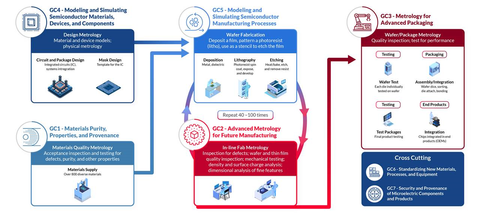
CHIPS for America Announces New CHIPS Metrology Community of Practice
On August 28, 2024, CHIPS for America announced the establishment of a new community of practice, the CHIPS Metrology Community. The Community will facilitate data and knowledge sharing across initiatives within the CHIPS Metrology seven Grand Challenges and help stakeholders inform the industry standards that are critical for enhancing U.S. economic and national security competitiveness.
Participation in the Community is open and available to members across the semiconductor industry, academia, consortia, and all stages of career levels, from engineers to executives.
To find out more about the CHIPS Metrology Community, including how to become a member, please click here.
Metrology plays a key role in semiconductor manufacturing. As devices become more complex, smaller, and multi-layered, the ability to measure, monitor, predict, and ensure quality in manufacturing becomes much more difficult and uncertain. Today, the domestic semiconductor industry faces some of these metrology challenges with workarounds and inadequate tools, limiting production yields, impacting quality, and increasing costs. As greater demands are put on semiconductor device performance and material requirements, these challenges will continue to intensify.
The CHIPS Metrology Program emphasizes measurements that are accurate, precise, and fit-for-purpose for the production of microelectronic materials, devices, circuits, and systems. This work leverages NIST’s proven measurement science expertise, foundational communications and computing research capabilities, standards development contributions, and stakeholder engagement practices to address the highest priority metrology challenges identified across industry, academia, and government agencies.
Key Research & Development Areas
In September 2022, NIST published a report titled Strategic Opportunities for U.S. Semiconductor Manufacturing, which identifies seven grand challenges that need critical attention from a metrology perspective to achieve the future state vision of a U.S.-led global semiconductor industry.

The CHIPS Metrology Program aligns its research and development portfolios based on the identified metrology needs of the seven grand challenges:
- Metrology for Materials Purity, Properties, and Provenance
- Advanced Metrology for Future Microelectronics Manufacturing
- Enabling Metrology for Integrating Components in Advanced Packaging
- Modeling and Simulating Semiconductor Materials, Designs, and Components
- Modeling and Simulating Semiconductor Manufacturing Processes
- Standardizing New Materials, Processes, and Equipment for Microelectronics
- Metrology to Enhance Security and Provenance of Microelectronic-based Components and Products
The CHIPS R&D Office published Metrology Gaps in the Semiconductor Ecosystem in July 2023, outlining the Metrology Program’s roadmap and its efforts to ensure that the research portfolio is aligned with CHIPS Act, external stakeholder needs, and NIST capabilities.
Projects launched by the CHIPS Metrology Program are listed below. This page will continue to be updated with additional projects.


